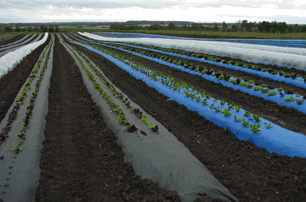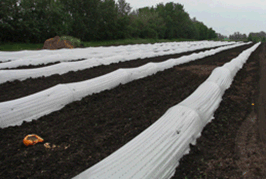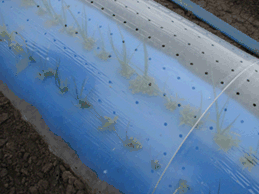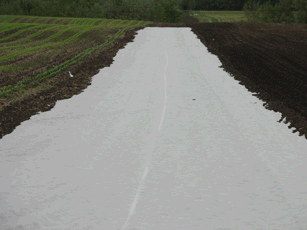| | Plastic mulches | Mini tunnels and floating row covers
The climate of the Canadian Prairies can make the production of warm season vegetable crops difficult. Early season soil and air temperatures are cool, slowing plant growth. This places limitations on growers, restricting them to varieties that will mature in a shorter time period. This results in a trade-off in overall quality and yield.
It is essentially impossible to modify a climatic area, other than by placing the whole growing system under cover. The modification of the environment around the roots and shoots of developing seedlings (microclimate) can extend the growing season slightly and provide many benefits, both in terms of yields and quality. Microclimate modification can be accomplished through the use of plastic mulches, mini-tunnels or floating row covers. Warm season crops respond the best to these practices.
Plastic Mulches
Plastic mulches are laid on a prepared soil surface that is free from trash and anchored using the weight of the soil on the edges. Mulch should be laid tightly, to ensure good heat transfer and prevent flapping and movement in the wind. Movement may cause the plastic to tear, eliminating the benefits. Plastic mulches are often used in conjunction with drip irrigation.

Photo Credit: Robert Spencer |
.
Physical Benefits of Plastic Mulch
- Increased soil temperatures (degree depends on mulch type)
- Reduced levels of weeds (depending on mulch type)
- Reduction in contact with soil and decay organisms
- Conserve soil moisture (less evaporation)
Disadvantages of Plastic Mulch
- Plastic must be removed and disposed of
- Greater initial costs
- An increased level of management is required
Plastic mulches come in a variety of colours, with a range of qualities for each type.
Type of Mulch | Advantages | Disadvantages |
Clear | Rapid heating; increases soil temperature (6-10C); moisture conservation | Weed growth; rapid heat loss (no heat trapping) |
Black | No weed growth; inexpensive; moisture conservation | Limited heating of soil (some transfer of heat with contact with soil) |
Wavelength Selective / Infrared Transmissible (IRT) | No weed growth; some soil heating (4-6C); moisture conservation | More expensive |
Coloured (red, yellow, blue, silver, etc.) | Similar to black; some reflection of different wavelengths of light may improve yield & ripening; moisture conservation | More cost; unproven benefits |
Biodegradable (different colours and characteristics) | Early benefits similar to other mulches; barrier not in place permanently; no need for removal; moisture conservation | May not fully break down in soil; benefits are lost as the mulch begins to break down |
Compostable (different colours and characteristics) | Early benefits similar to other mulches; no removal requirement; compatible with organic production systems; moisture conservation | Lose benefits of mulch at a variable rate |
Organic (bark mulch, straw, wood chips, etc.) | Soil cooling & moisture conservation | Slow to warm; can tie up nutrients as breaks down; may harbour rodents |
Other General Benefits of Mulches
- Increased soil temperatures improves early season plant establishment
- Increased soil temperatures accelerates early season plant growth, translating into earlier crop maturity and increased returns
- Weed control reduces competition for water and nutrients
- Increased plant vigour translates into increased final yields
- U of Saskatchewan trials observed melon yield increases of up to 73% compared to bare soil controls.
- The use of coloured mulches may improve fruit yield and quality of some vegetable crops, although results are variable
Mini Tunnels and Floating Row Covers
Mini tunnels involve the placement of plastic or spun-bonded fabric sheets on metal hoops over the developing crop, resulting in a mini-greenhouse effect. Plastic is usually clear and may be solid or perforated. This cover is left on for 3-4 weeks, depending on the crop. Mini tunnels are often used in conjunction with plastic mulches and drip irrigation.

Photo Credit: Robert Spencer | 
Photo Credit: Robert Spencer |
Benefits of Mini tunnels
- Increased daytime air temperatures can enhance the growth rates of crops
- Perforated covers can reduce the level of manual labour required for ventilation, but do not hold temperatures for as long as solid plastic
- Covers can protect crops from insect pests
- Spun-bonded fabric will allow passage of rain and irrigation
Disadvantages of Mini tunnels
- High daytime temperatures in the spring can result in excessively high tunnel temperatures, impacting flower development and plant survival
- Labour intensive to install
- May require a lot of labour to ventilate
- Can form a barrier to pollinating insects &/or precipitation (solid plastic)
Floating Row Covers are very large sheets of spun-bonded fabric (range of thicknesses available) that “float” over or lie on the developing crop. The material is anchored on the edges with soil, sandbags or rocks. Crops may be direct seeded or transplanted.

Photo Credit: Robert Spencer
Benefits of Floating Row Covers
- Do not impede seedling emergence while increasing plant growth through soil and air temperature increases
- Rain or irrigation can pass through the fabric freely
- Finer weaves can prevent entry of some insect pests
- Can provide some frost protection in the fall and spring
Disadvantages of Floating Row Covers
- Movement in wind can damage some crops
- High winds can be problematic
- Cover must be removed to allow entry of pollinating insects = lots of labour
- Can delay early fruit set in some crops (e.g. tomatoes)
- Weed growth can be extensive
References / Additional Resources:
Vegetable Cultivar and Cultural Trials 1996, 1997, 1998”, D. Waterer & J. Bantle, University of Saskatchewan, Dept. of Horticulture Science
Centre for Plasticulture – Penn State
Prepared by Robert Spencer, Ag-Info Centre, Alberta Agriculture and Forestry |
|